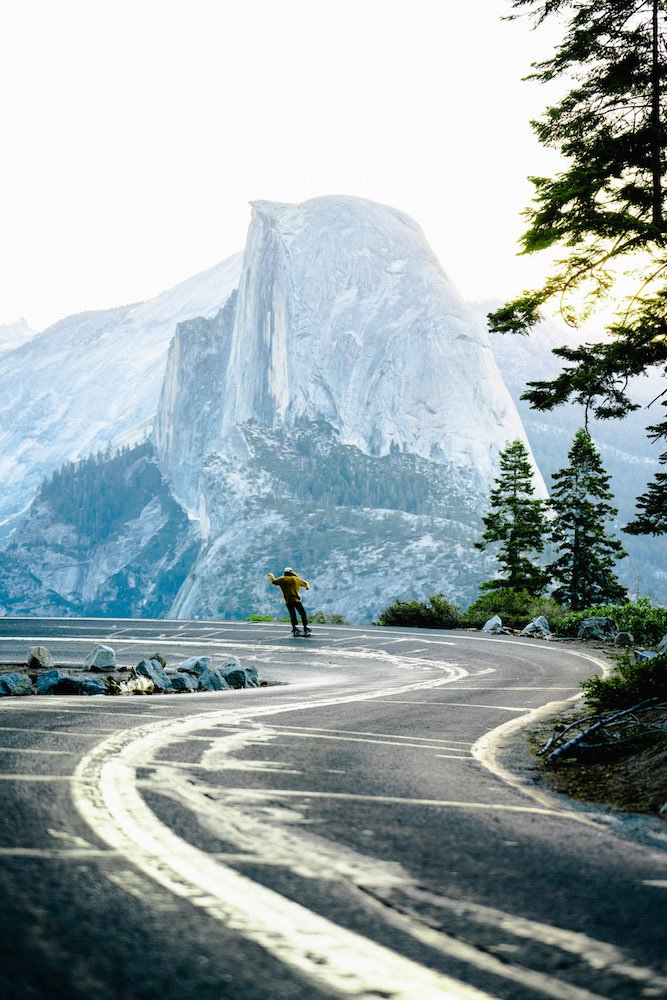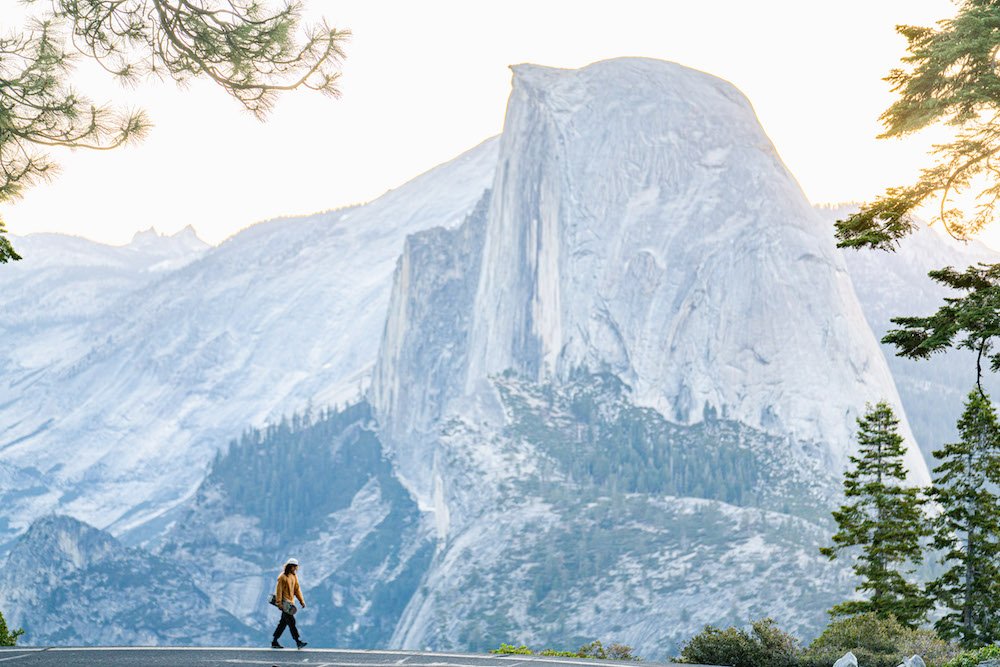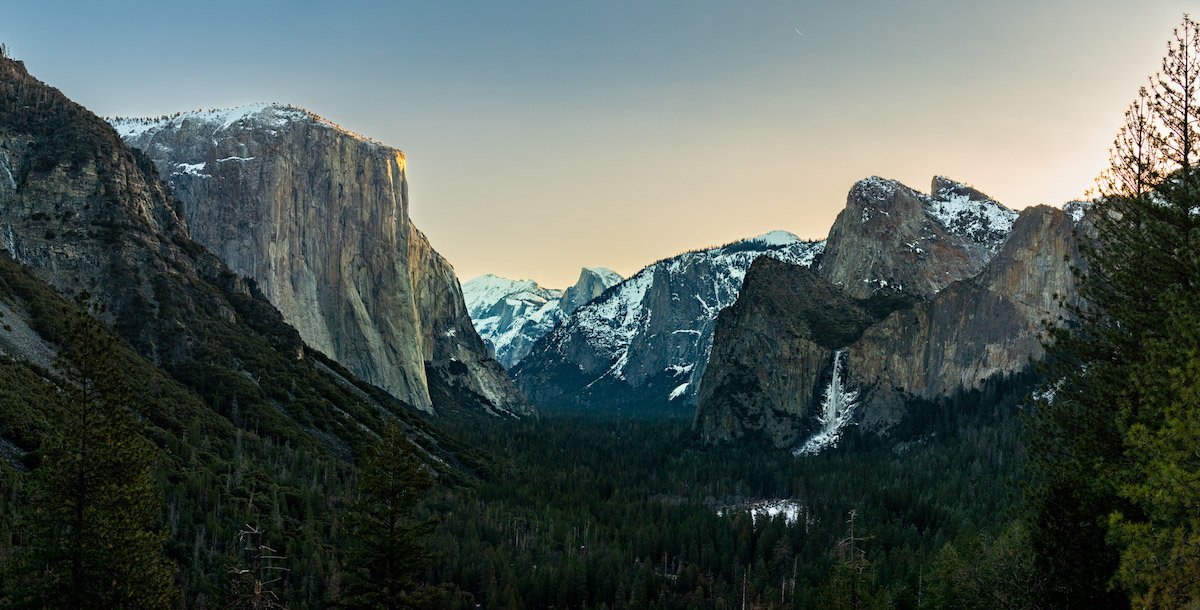Sunrise or Sunset at Glacier Point in Yosemite, I Prefer Sunrise
There’s a timeless debate among Yosemite visitors: Is Glacier Point better at sunrise or sunset? My personal favorite is sunrise, but everyone’s experience will differ. Having visited Glacier Point more than 20 times across different seasons (except winter, which I’m eager to change), I’ve gathered insights to help you decide when to visit. Here are some personal stories, pros, cons, and tips to make the most of your visit.
Skating at sunrise along Glacier Point Road. Photo by Dalton Johnson
Sunrise at Glacier Point: Golden Light and Adventure
If you love the calm of peaceful mornings, where soft, golden light bathes the landscape in warmth, sunrise at Glacier Point is an extraordinary experience. The serenity, paired with the majestic views of Yosemite Valley and Half Dome, makes the early wake-up call worthwhile. Beyond the stunning scenery, sunrise here offers a unique opportunity to connect with nature in a quieter, more personal way. Here’s why I highly recommend making the effort to witness this magical time of day:
1. Quiet Mornings with Unique Adventures
One of my favorite sunrise visits was with a few friends. We brought a skateboard and spent the morning snapping photos as they skated down the winding roads. The soft morning light created a magical backdrop. Afterward, we ventured to the diving board area to capture some fun images of them dancing close to the edge. It was thrilling yet serene—a memory etched in my mind forever.
2. Fewer Crowds and Tranquility
At sunrise, Glacier Point is nearly empty. Most visitors are still asleep, giving you a rare opportunity to enjoy the breathtaking views without interruptions. It’s the perfect time to reflect and fully immerse yourself in the natural beauty of Yosemite.
3. Potential for Hang Gliding Sightings
Occasionally, a group of hang gliders will appear, launching off the cliffs and soaring over Yosemite Valley and Half Dome. The sight of them gliding gracefully adds an unexpected thrill to an already stunning morning. I’ve always wanted to try it myself after watching them.
Dancing at sunrise at the diving board of Glacier Point. Photo by Dalton Johnson
4. Starting Your Day Right
The peaceful atmosphere and golden light make sunrise an energizing way to begin your Yosemite adventure. The distinct shadows and highlights add depth to the landscape, making the experience feel even more special.
5. A Chance for Creative Photos
The soft light of sunrise provides the perfect conditions for capturing unique photos. Whether it’s landscapes, portraits, or action shots like the skateboarding session I enjoyed, the lighting is ideal for experimentation.
Related Read: The Complete Photography Guide to Yosemite's Glacier Point
Cons of Sunrise:
Early Wake-Up Call: You’ll need to wake up very early, often in the dark, to make it to Glacier Point before sunrise. This can be challenging, especially after a long day of hiking or exploring Yosemite. Preparing the night before with all your gear packed can help mitigate the stress.
Cold Morning Temperatures: Early mornings at Glacier Point can be quite chilly, especially in spring or fall. Dressing in layers is essential to stay comfortable while you wait for the sun to rise.
Limited Wildlife Sightings: Wildlife sightings are rare here due to the number of visitors. If you were hoping for a peaceful encounter with Yosemite's animals, sunrise at Glacier Point may not be the best option.
Road Conditions: Depending on the time of year, the drive to Glacier Point can be more challenging in the pre-dawn hours. Fog or icy conditions might require extra caution and preparation.
Sunset alpine glow on Half Dome from Glacier Point. Photo by Dalton Johnson
Sunset at Glacier Point
If you’re drawn to vivid colors, awe-inspiring skies, and the dramatic close of a day, sunset at Glacier Point offers a truly mesmerizing experience. There’s something magical about watching the sky transition from warm hues of gold and orange to deeper purples and blues, all while the landscape reflects these changing tones. Sunset brings an energy and vibrancy that contrasts beautifully with the serenity of sunrise, creating moments that feel both grand and intimate. Here’s what makes it an unmissable experience:
1. Romantic Evenings with Stunning Views
One unforgettable sunset was with my girlfriend. We watched as the alpenglow lit up Half Dome, painting the landscape in rich, warm hues. Later, we stayed to photograph the Milky Way over Half Dome—a perfect blend of romance and awe-inspiring beauty.
2. Dynamic and Dramatic Skies
Sunsets often bring striking cloud formations, creating a dramatic contrast with the serene landscapes below. Depending on the weather, you might even witness colorful alpenglow on the surrounding peaks. It’s the kind of moment that stays with you long after the sun has set.
3. Starry Nights Await
After sunset, stick around for stargazing. Glacier Point’s elevation and minimal light pollution make it one of the best spots in Yosemite to view the Milky Way and constellations. Bring a blanket and some hot cocoa for an unforgettable evening under the stars.
4. A Photographer’s Dream
The changing hues of the sky and the glow on Half Dome create incredible photography opportunities. Whether you’re an amateur or a seasoned pro, you’ll find endless inspiration.
Cons of Sunset:
Crowds and Noise: Sunset tends to draw larger crowds compared to sunrise, especially during the summer and on weekends. The bustling environment can detract from the serene experience many visitors seek.
Finding Parking: With more people visiting at this time, parking can become a significant challenge. Arriving early is critical to secure a spot, especially during peak tourist seasons.
Long Drive Back: After a full day of exploring, the drive back to camp or your lodging can feel exhausting. Navigating the winding roads in the dark also requires extra caution.
Cooler Temperatures After Sunset: While the temperature is usually pleasant during sunset, it drops quickly once the sun goes down. If you stay for stargazing, you’ll need extra layers to stay warm.
Limited Dining Options: If you plan to stay late, note that many of Yosemite’s dining options close early, so having snacks or a packed meal is essential to avoid hunger after sunset.
Hidden Gems and Quiet Spots Around Glacier Point
While sunrise and sunset are magical, Glacier Point offers incredible experiences at other times too. Exploring during different hours can reveal Yosemite’s beauty in new and unexpected ways.
Midday Exploration
Midday light highlights the rugged textures and vibrant colors of Yosemite’s granite cliffs. It’s also an excellent time for a picnic or relaxed sightseeing. This is particularly suited for families or visitors who prefer a more flexible schedule.
Crocker Point with no one else around. Photo by Dalton Johnson
Less Busy Areas to Explore
If Glacier Point feels too crowded, try these quieter spots:
Taft Point: A short drive and hike from Glacier Point, this spot offers stunning views with fewer visitors. It’s my favorite place to watch the sunset.
Crocker Point: Lesser-known but equally beautiful, it’s another great choice for a serene sunset experience.
Sentinel Dome: While some of its views are partially blocked, it’s much quieter and still offers a unique perspective of Yosemite.
Washburn Point: Located just before Glacier Point, this spot provides similar views with a quieter atmosphere.
Stargazing
Glacier Point’s stargazing opportunities are unmatched. Yosemite’s minimal light pollution ensures clear skies, making it a prime spot for viewing the Milky Way and constellations. Check Yosemite’s calendar for ranger-led astronomy programs to enhance your experience.
Seasonal Highlights
Each season brings something special to Glacier Point. Spring offers blooming wildflowers and rushing waterfalls, while fall provides vibrant foliage. Summer skies are often clear for stargazing, and winter, though challenging to access, transforms Yosemite into a snowy wonderland.
Tips for a Memorable Visit TO Glacier Point
Arrive Early: Whether visiting at sunrise or sunset, arrive at least 30 minutes beforehand to secure a good viewing spot.
Pack Essentials: Dress in layers, bring snacks, water, and a flashlight if you plan to stay after dark.
Scout Locations: Familiarize yourself with Glacier Point during the day to find the best spots.
Check Weather Conditions: Weather can greatly influence the experience, so plan accordingly.
Be Respectful: Stay on marked trails and leave no trace to preserve Yosemite’s beauty.
Stay Safe: Be cautious near cliff edges and supervise children in these areas.
Bring Binoculars: For a closer view of Half Dome, wildlife, or hang gliders, binoculars can add to your experience.
Skating the road to Glacier Point. Photo by Dalton Johnson
Whether you visit at sunrise or sunset, Glacier Point offers unforgettable experiences. Sunrise provides peace, soft light, and tranquil moments, while sunset delivers vibrant colors and dramatic landscapes. Both times have their charm, and you truly can’t go wrong.
Don’t limit yourself to just these golden hours. Explore during midday, embrace the quiet serenity of lesser-known spots, or marvel at the night sky. Each visit to Glacier Point reveals something new, making it a destination you’ll want to return to again and again. With some planning and a sense of adventure, your visit to Glacier Point will leave you with lasting memories of Yosemite’s breathtaking beauty.












